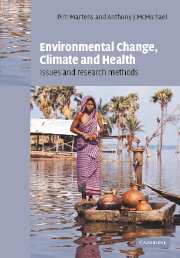Book contents
- Frontmatter
- Contents
- List of contributors
- Foreword
- 1 Global environmental changes: anticipating and assessing risks to health
- 2 Historical connections between climate, medical thought and human health
- 3 The contribution of global environmental factors to ill-health
- 4 Surprise, nonlinearity and complex behaviour
- 5 Epidemiological and impacts assessment methods
- 6 Retrospective studies: analogue approaches to describing climate variability and health
- 7 Detecting the infectious disease consequences of climate change and extreme weather events
- 8 Integrated Assessment modelling of human health impacts
- 9 Remote sensing, GIS and spatial statistics: powerful tools for landscape epidemiology
- 10 Monitoring the health impacts of global climate change
- 11 Epidemiology, environmental health and global change
- 12 Dealing with scientific uncertainties
- Index
- Plate section
- References
11 - Epidemiology, environmental health and global change
Published online by Cambridge University Press: 28 July 2009
- Frontmatter
- Contents
- List of contributors
- Foreword
- 1 Global environmental changes: anticipating and assessing risks to health
- 2 Historical connections between climate, medical thought and human health
- 3 The contribution of global environmental factors to ill-health
- 4 Surprise, nonlinearity and complex behaviour
- 5 Epidemiological and impacts assessment methods
- 6 Retrospective studies: analogue approaches to describing climate variability and health
- 7 Detecting the infectious disease consequences of climate change and extreme weather events
- 8 Integrated Assessment modelling of human health impacts
- 9 Remote sensing, GIS and spatial statistics: powerful tools for landscape epidemiology
- 10 Monitoring the health impacts of global climate change
- 11 Epidemiology, environmental health and global change
- 12 Dealing with scientific uncertainties
- Index
- Plate section
- References
Summary
Introduction
This chapter outlines the approach that is typically taken in epidemiology to the study of disease risk, gives examples of studies that currently serve as paradigms for epidemiological thinking, and compares these traditional approaches with what is needed to understand health problems associated with global environmental change. It is argued that in order to meet this new challenge, epidemiology must encompass three things: models of extended causation, multiple levels of analysis, and differential vulnerability to disease and injury. This chapter examines in detail the concept of vulnerability, the condition of individuals or groups that modifies the effect of environmental exposures on disease outcomes.
Modern epidemiology is both useful and wrong. By this I mean that epidemiology is an asset to public health because it points out ways to prevent disease and injury, but the foundations of the enterprise are shaky. “Wrong” is putting it strongly – “limited” may be closer to the mark. When you look closely you can see that the methods used by epidemiologists assume a world that does not exist. This is not a criticism of epidemiology, rather an observation on the way that science in general works. Like all scientific disciplines, epidemiology is a tool for creating knowledge. All tools provide partial and incomplete access to the external world because they themselves are imperfect reflections of the world. (Hammers assume there is not a plank that cannot be nailed; telescopes presuppose a universe in which all that matters can be seen.)
- Type
- Chapter
- Information
- Environmental Change, Climate and HealthIssues and Research Methods, pp. 290 - 310Publisher: Cambridge University PressPrint publication year: 2002
References
- 1
- Cited by



